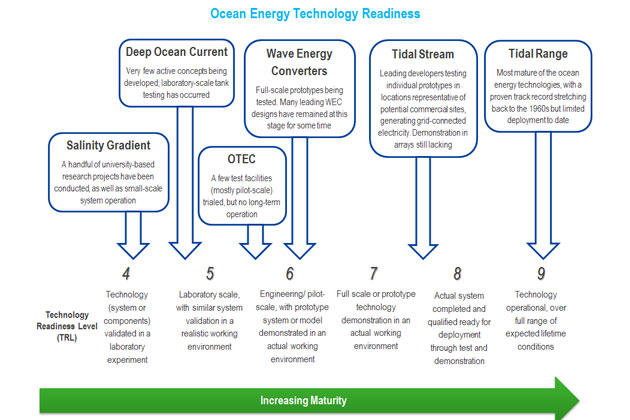

Ocean Energy: Technologies, Patents, Deployment Status and Outlook
Newsletter
The potential of oceans as an energy source is staggering – more than sufficient to meet global electricity demand well into the future.
Ocean resources vary from tidal currents and waves, to temperature and salinity gradients. Ocean energy technologies could contribute to energy independence, decarbonisation and job creation. Existing patents and announced projects span the globe, with hotspots of activity in the UK, France, USA, Australia, Canada, France, Japan, the Republic of Korea, the United Kingdom and the United States.
Yet the contribution of ocean energy to the world’s energy mix remains very small, with key technologies still in development and demonstration phases. For most ocean energy technologies, the main challenge is to reduce costs and improve system reliability and performance, in order to ensure sustained, commercially competitive energy costs.

The International Renewable Energy Agency (IRENA) has released an overview report and four technology briefs on ocean energy.
- Ocean Energy: Technology Readiness, Patents, Deployment Status and Outlook (report);
- Ocean Thermal Energy Conversion: Technology Brief
- Salinity Gradient Energy: Technology brief
- Tidal Energy: Technology brief
- Wave Energy: Technology brief
FULFILLING THE POTENTIAL: OVERCOMING BARRIERS
Levelised costs of ocean energy technologies are currently substantially higher than those of other renewable energy technologies. Commercial maturity is expected from the 2020s onwards, with cost reductions largely depending on deployment, investment, learning and innovation rather than just on time. Fulfilling the potential of ocean energy requires overcoming technical, economic, environmental, social and infrastructural hurdles.
Techno-economic
- Conduct a resource mapping exercise to identify the most suitable ocean energy technologies for each location
- Make capital grant funding available for research and demonstration of prototypes and the first small arrays and encourage the spreading of risk among multiple stakeholders
- Promote sharing of best practices and support test centres to accelerate learning from practical experience
- Promote international collaboration, technology transfer and collaborative research, development and demonstration of ocean energy technologies
- Provide a premium price per unit of energy generated to signal the creation of a long-term market
- Promote niche applications in such areas as aquaculture, cooling, water desalination and sustainable tourism
- Quantify additional benefits, so that the full added value of ocean energy technologies is recognised
- Accelerate cost and risk reduction through roadmapping
Environmental and social
- Remove bottlenecks in the process of granting consent for ocean energy technology deployment applications
- Improve access to baseline data
- Incorporate ocean energy development in national maritime spatial plans
- Consult and engage the public early on
Infrastructure
- Include ocean energy technologies in network planning in a fair and transparent way
- Promote supply-chain opportunities
Long-term viability for island communities
Islands are richly endowed with different types of ocean energy resources, depending on their geographic location. As such, ocean energy could be a long-term clean energy source contributing to the energy needs of island communities. In recent years, different ocean energy converters have been demonstrated on islands: the Canary Islands, Hawaii, La Réunion, Martinique and New Zealand, among others. However, no commercial ocean energy plant exists yet, nor is foreseen in the short term for any island.




